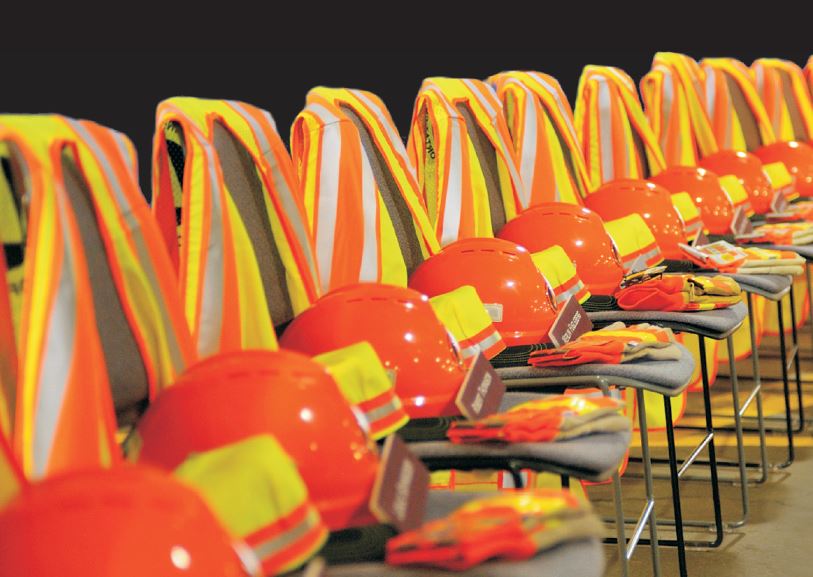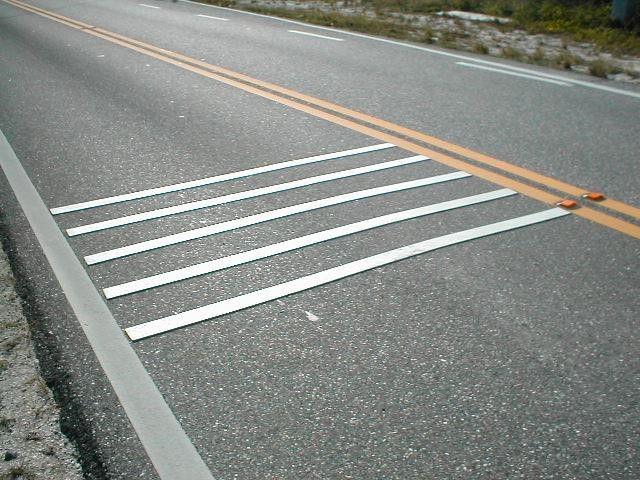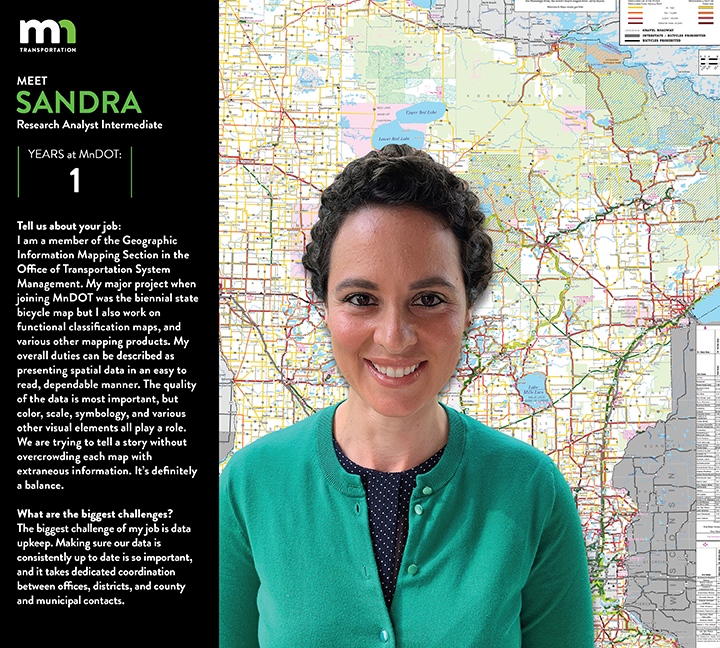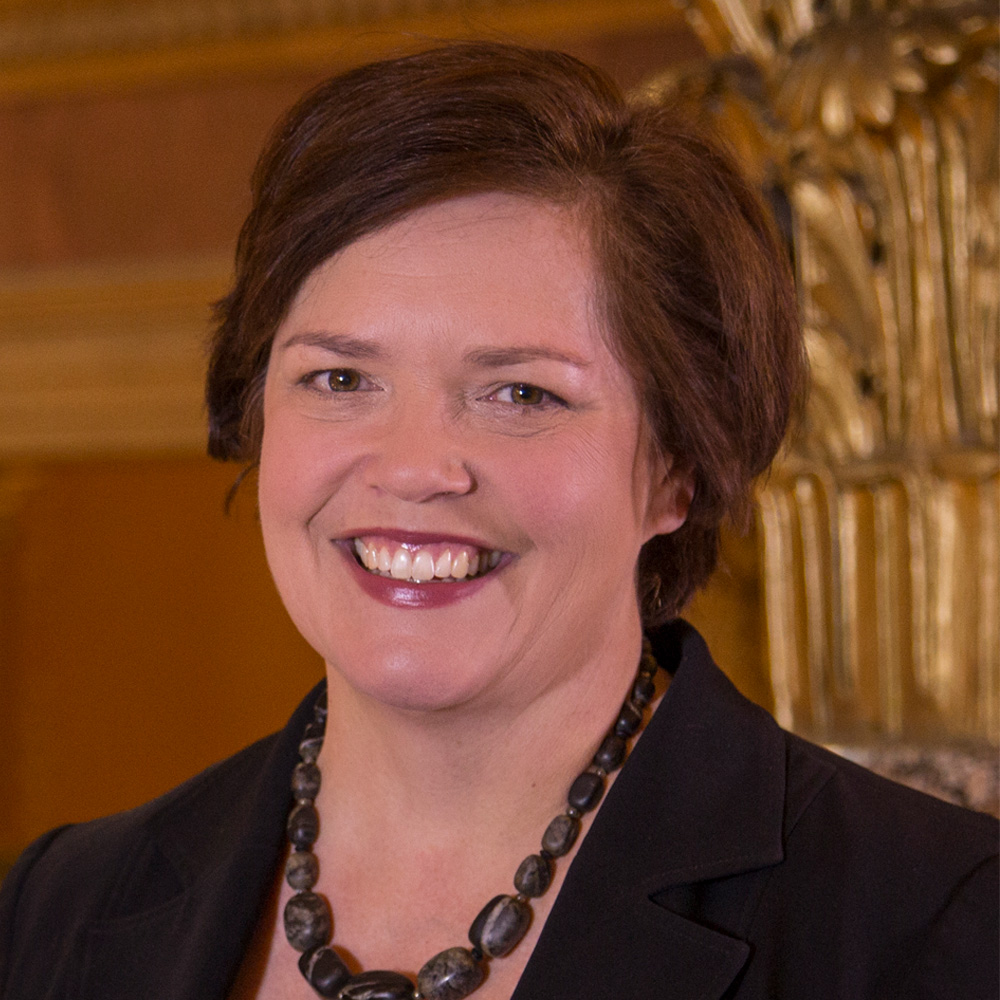 |
|

|
 |
TABLE of CONTENTS
 |
Remembering fallen, injured workers on Worker Memorial Day |
By Anne Meyer

MnDOT file photo |
Since 1960, 35 MnDOT employees and 15 private sector contractors have been killed on the job. Many other employees have also been injured.
These workers were remembered Tuesday, April 28, on Worker Memorial Day. Unlike in years past, however, districts did not host any public events this year due to COVID-19.
Commissioner Margaret Anderson Kelliher recorded a special message to employees to honor Worker Memorial Day. The message is available on MnDOT’s YouTube channel. Anderson Kelliher also sent a message to employees via NoteMailer.
“Every day we work hard to ensure that all of our workers can do their jobs safely and return to their families at the end of the work day,” she said. “We also need the cooperation of motorists. We get safety messages out to the public through a variety of communications efforts statewide. News media, social media and electronic message boards tell drivers to slow down, stay alert in a work zone and to watch for signs, equipment and workers. We also need drivers to minimize distractions behind the wheel.
“It’s also important that all of us, as MnDOT employees, take individual responsibility and champion safety as we drive through work zones while working and in our everyday lives,” she said.
The Interstate 35W Bridge in Minneapolis was lit orange Tuesday night as part of the Worker Memorial Day observance.
Visit MnDOT’s Worker Memorial website to learn more about each fallen worker and read Gov. Tim Walz’s Worker Memorial Day proclamation.
|
 |
|

|
 |
TABLE of CONTENTS
 |
Operations keeps maintenance, construction moving forward |
|
By Joseph Palmersheim

The Lake City Highway 61 Reconstruct Project started April 15 with crews removing the pavement. Jay Hietpas, assistant commissioner of Operations, said construction projects are "moving forward pretty well," despite impacts from COVID-19. Photo by Sheila Thoma |
While much of the state hunkers down and waits for what comes next with COVID-19, MnDOT continues to provide valuable service to the state’s transportation systems.
“Overall, we have been able to keep our maintenance, construction and design projects moving forward pretty well,” said Jay Hietpas, assistant commissioner of Operations. “We have really great teams working on these items. The largest impact are typically things we can’t control, such as getting information or approvals from third parties.”
While MnDOT may lead projects, cooperation and partnership from other entities (like cities, counties, tribes and private businesses) are needed to complete the work. All of these agencies and businesses are also impacted by COVID-19. Hietpas said MnDOT is finding creative ways to obtain approvals from railroads, utility companies and permitting agencies, and negotiating agreements with other government agencies. Some partners are simply unable to perform needed services. Projects can be affected by things like courthouses having their hours reduced, or having non-MnDOT staff unavailable for project-related work.
On the maintenance side of things, one of the biggest challenges is keeping roadways and bridges open to the public while balancing the safety of field workers.
“There are certain things we need to fix and maintain in order to keep the roads open and safe, such as plowing, and fixing guardrail, signs, signal systems and large potholes,” Hietpas said. “Much of our work, especially in maintenance, requires our crews to work together. Trying to quickly find new ways to achieve this critical work, while social distancing, has been a challenge. Our innovative crews are finding new ways to utilize different equipment and techniques to accomplish the work.”
With so many variables, contingency planning has also been critical. The Operations Division has done scenario planning on how to deal with potential impacts to construction inspection teams or maintenance truck stations, including how one truck station could cover for another. Other planning has involved partnering with other state and local agencies, and using the private workforce.
“We don’t know where or when COVID-19 will impact our workforce, and what the impact will be,” Hietpas said. “We need to keep our critical services going. I just want to say ‘thank you’ to all of the operations team, but especially those individuals who can’t telework. They are keeping our essential services going in the field. They are the ones who make sure medical supplies can be delivered, store shelves are being stocked with food and other essential items, and are helping keep the Minnesota economy going.”
|
 |
|

|
 |
TABLE of CONTENTS
 |
Public Engagement finding new ways to connect |
By Joseph Palmersheim
When public events are cancelled, how does one go about engaging the public?
MnDOT’s Public Engagement program addressed this question following the postponement of all public meetings and project open houses statewide last month.
“The Covid-19 pandemic really pushed us to start exploring new ways of engaging with the public and our stakeholders virtually,” said Renee Raduenz, interim Public Engagement and Constituent Services director. “This was something that we’ve wanted to do, but without the ‘push,’ had not taken the step. Learning new technologies and tools can be challenging to navigate upfront, but over time it will get easier. We’ll have access to more public engagement methods and tools to engage a variety of audiences, which will ultimately serve MnDOT better in the long run.”
Engagement staff have explored a variety of options to stay connected with the public. Online tools include Skype, WebEx (for meetings, events and trainings), Facebook Live and Premiere, and live streaming. Other tools include online surveys, videos, mailings and a Gov Delivery texting pilot program currently being tested in Districts 4 and 6.
Here is how some of the efforts have gone so far:
District 8 hosted two virtual open houses for Hwy 12 in Litchfield and Hwy 15 in Hutchinson. Another is in the works for the Hwy 23 Cottonwood to Granite Falls concrete resurfacing project.
“All three of these projects have many components, which typically draw a lot of interest and questions from the public,” said Sandra Schlagel, District 8 public affairs coordinator. “They’re similar to a PowerPoint presentation given at an actual open house. They present the project information in a logical order that would hopefully answer people’s questions about what is going to take place, when, and how will they be able to get to their destinations in the area during construction. There is a comment button for people to submit questions to the project team. In essence, they tell the project story in an organized way.”
District 6 recently started the first in a series of weekly, live WebEx meetings for the Hwy 61 reconstruction project in Lake City. Online viewers can ask questions via a comment box.
“We’re hoping for an opportunity for the community to learn about the week’s construction project while providing rich information in a conversational way,” said Cynthia Morgan, District 6 public engagement coordinator. “Before the pandemic, we had promised weekly public meetings for the community and business owners; this is our way of offering that same opportunity but in a safe way.”
Online open houses or meetings are one tool in the toolkit. Another is using an online survey, like District 4 staff did for a 2023 project on Hwy 55/Hwy 59 between Elbow Lake and Barrett. Staff promoted the survey link by sending letters directly to residents/land owners, distributing a news release to local media, running an ad on Facebook targeting that local area, and sharing the survey link on social media pages.
“As of April 17, we had 194 responses,” said Emma Olson, District 4 public affairs coordinator. “It’s definitely a great response rate in comparison to the assumed attendance we would have seen at an open house. We are very happy with the results, and the survey will still be open for another week, so I’m hopeful we’ll get to well over 200 responses by that point.”
The survey is also available in alternate formats, including paper and over-the-phone.
Some districts have tailored their approach to best meet the way that their district’s residents communicate. In District 3, that involved an increase in the number of mailings sent out. Jenny Seelen, communications and web coordinator, said a letter with a detour map is normally sent out for bigger projects. The latest mailings featured a project fact sheet that also included traffic impacts, detour map, contacts and project website.
“We chose mailings because they are sent directly to residents’ homes,” Seelen said. “Not all residents have technology. This gives them a phone number to call and provides detour details. This is usually used for rural reclaim jobs, when the project is 6 miles long and we close the road for the entire summer or half the summer.”
Different tactics may work better for different audiences, but it may take all of these tools together to reach a wide range of audiences in planning and project development efforts.
“We need to offer a variety of methods for people to engage with MnDOT,” Raduenz said. “Living through a pandemic doesn’t change this. While our focus right now has turned to other methods, like mailings and online meeting/conferencing tools, I envision these methods will continue to be used, with even more frequency, in the future.”
|
 |
|

|
 |
TABLE of CONTENTS
 |
Finding inspiration in Earth Day |
By Mary McFarland Brooks

Scott Bradley, assistant office director, Construction and Operations Section of OES, collects litter by bike. Photo by Cynthia Bradley |
Despite many Earth Day celebrations this year having to become virtual events due to COVID-19, Office of Environmental Stewardship staff found a way to embrace the occasion in their local neighborhood cleanups on April 22.
Twelve staff members did individual litter pickups in their respective neighborhoods, observing social distancing due to the solo nature of the work. These workers picked up litter at Minnehaha Creek, the Mississippi River, roadsides in Forest Lake, creeksides in Farmington and street sides in Hager City. The Glacial Lakes State Trail was also tidied up in Spicer. Finally, staff planted trees and shrubs on city streets in various Twin Cities metro area neighborhoods.
Participating staff members included Luke Charpentier,
Scott Bradley,
Ken Graeve,
Jackie Klein,
Chris Ochs,
Tina Markeson,
Brian Kamnikar,
Tara Carson,
Chris Smith,
Katie Haun Schuring and
Nate Johnson.
Now in its 50th year, Earth Day continues to evolve. The event went global in 1990, mobilizing 200 million people in 141 countries. By 2000, the power of digital media spread the movement more than 180 countries, and by 2010, Earth Day engaged 75,000 global organizations in 192 countries.
Closer to home, MnDOT was part of what became the Minnesota Earth Day Network, a group of nonprofits and state agencies that grew to a membership of more than 100 organizations and promoted environmental awareness from 1991 through 1998.
“As one of the founding members of the Minnesota Earth Day Network there was a sense of commitment to providing a forum for environmental ideas, information, resources, and actions to make every day Earth Day,” said Scott Bradley, assistant office director, Construction and Operations Section of OES. “I’m proud that Minnesota’s organizational name and working model is now used nationally and globally as the Earth Day Network.”
Minnesota continues to lead in environmental research.
“Climate change & the environment is one of the research priorities that guide our work, said Katie Walker, research and innovation office director. “This includes research projects on endangered species, wetland protections, salt use and congestion impacts on air quality.”
Mitigating the impacts of road construction and maintenance activity on the environment continues to be a significant concern for the agency.
MnDOT’s Sustainable Transportation Advisory Council kicked off its first meeting in March. The council’s mission is to advise the agency on strategies for reducing carbon pollution. Commissioner Margaret Anderson Kelliher and Xcel Energy president Chris Clark co-chair the group of 23 appointed leaders from the public, private, and nonprofits sectors, including state legislators.
“As we celebrate our success, let’s also keep in mind the challenges ahead as we tackle a climate crisis that threatens to undo much of what we’ve accomplished for the environment and public health,” said Tim Sexton, assistant commissioner and chief sustainability officer. “Hopefully, we can all be inspired by the success of the Earth Day movement to work together for a climate-friendly and prosperous future for generations to come.”
|
| |
|

|
 |
TABLE of CONTENTS
 |
Transverse rumble strips: another tool for rural road safety? |
By Micaela Resh, Office of Research & Innovation

Example design of temporary raised transverse rumble strips that will be used in the study. MnDOT staff photo |
Rural intersections account for 30 percent of crashes in rural areas and 6 percent of all fatal crashes, representing a significant but poorly understood safety problem.
Transverse rumble strips are one low-cost measure deployed by some states to reduce rural intersection crashes.
More common to Minnesotans are traditional rumble strips. These pavement indentations are usually applied along the shoulders or centerline to cause noise and vibration when a vehicle drives over them. They are widely used on Minnesota roads.
Transverse rumble strips, however, are located across the lane (or exclusively in the main wheel path), with the purpose of alerting motorists to an upcoming intersection with a stop sign along a rural roadway. This way, drivers don’t unintentionally run the stop sign, especially during times of low visibility.
The effectiveness of transverse rumble strips has shown mixed results. Experts believe this may be partly due to collisions caused by driver misperception of traffic gaps rather than failure to stop for stop signs.
“There is a lack of consistency in the placement and pattern for transverse rumble strips among U.S. transportation agencies,” said Shauna Hallmark, director of the Institute for Transportation at the Iowa State University.
In a new research project funded by the Local Road Research Board, Hallmark and other researchers from Iowa State University will assess the effectiveness, as well as the best design, of transverse rumble strips for possibly more widespread application in Minnesota.
Researchers will test three to five different transverse rumble strip designs by varying placement, the number of panels and patterns. They plan to collect video data before installation, one month after, and six months after to assess changes in driver behavior.
“Transverse rumble strips are one tool in the rural safety toolbox,” said Victor Lund, St. Louis County traffic engineer. “We want to learn when and how to best use this tool so we can get it back in the hands of local practitioners.”
Lund is leading an advisory panel of county and state traffic engineers that includes MnDOT’s Scott Thompson, District 7, and Marc Briese, State Aid.
In addition to evaluating their effectiveness, Hallmark’s team will look for a design that is palatable to Minnesotans.
“People have a love-hate relationship with rumble strips,” she said. “Drivers love the protection they offer, but nearby homeowners hate the noise. We want to identify the most effective, yet also quietest design possible.”
To request project updates or learn more, visit MnDOT’s Office of Research & Innovation.
|
 |
|

|
 |
TABLE of CONTENTS
 |
‘We miss you’ – District 2 video celebrates employee connections despite distances |
|
By Joseph Palmersheim
Staff in District 2 were recently treated to a morale-boosting video produced by the district’s Diversity and Inclusion Committee.
The three-minute video sprung from conversations about how employees, working from home and feeling disconnected, could be reminded of how they were part of “our MnDOT family,” said Leslie Seitz, public affairs coordinator.
“We wanted to find ways to reach out to our workers in the field, as well as others who are teleworking,” she said. “I reached out to my co-workers to send me pictures or videos of their new work environments. I created the video to remind the district, although we aren’t together physically, we still have important work to do and we need each other to get through this difficult time.”
The D&I committee also sent out thank-you cards across the district to groups working in the field.
“I believe both the video and the cards were well received,” Seitz said. “I think each individual is affected differently during this time. I felt a responsibility as a committee member to reconnect our district, and I hope that the video helped to do just that.”
|
 |
|

|
|

|
 |
TABLE of CONTENTS
 |
On the Job: Sandra Yassin makes each map tell a story |
By Rich Kemp
Sandra Yassin started as a research analyst intermediate in January 2019. In that role, she is tasked with presenting spatial data in an easy-to-read form. We caught up with her recently to learn more about her job. The image below is linked to a larger version.

Do you or a co-worker have an interesting job to share with readers? Send us your ideas, and we’ll contact you for more information.
Recent employee profiles:
|
 |
|

|
 |
TABLE of CONTENTS
 |
Observing Earth Day, 50 years on |
By Commissioner Margaret Anderson Kelliher

Margaret Anderson Kelliher. Submitted photo |
I want to thank you all for your efforts to make MnDOT a leader in protecting the environment. Every individual act in our agency of 5,000 employees can result in improving the environment and the way we do business at MnDOT.
April 22 marked the 50th annual Earth Day. On the first Earth Day in 1970, 20 million Americans came together in bipartisan support of the environment, leading to passage of the Clean Air Act, Clean Water Act, Endangered Species Act and creation of the Environmental Protection Agency. In 2020, Earth Day is celebrated by more than one billion people in 192 countries.
At MnDOT, the Office of Sustainability and Public Health’s Pathways to Decarbonizing Transportation annual report is pointing the way for us to address greenhouse gas emissions as an agency and as a community. With the creation of the Sustainable Transportation Advisory Council this year, MnDOT has demonstrated our commitment to environmental leadership with the Council working together with the private and nonprofit sectors to reduce carbon pollution from transportation throughout the state.
Our Office of Environmental Stewardship also is working daily to protect state waterways, while promoting native roadside habitat for pollinators and birds and ensuring that the agency meets - or exceeds - environmental compliance in project design and construction.
I’m confident that whether it’s reducing the carbon footprint of construction, designing infrastructure that will withstand increased flooding and other extreme weather events, reconnecting habitats to facilitate the movement of plants and wildlife, or supporting autonomous vehicles and other yet-to-be-conceived technologies, the future is bright and the possibilities are unlimited here at MnDOT.
We look forward to being able to celebrate Earth Day together in future years and MnDOT applauds the work that the Minnesota Pollution Control Agency and others in Enterprise Minnesota do to make our state the great environmental model it is.
|
 |
|
| |
|



